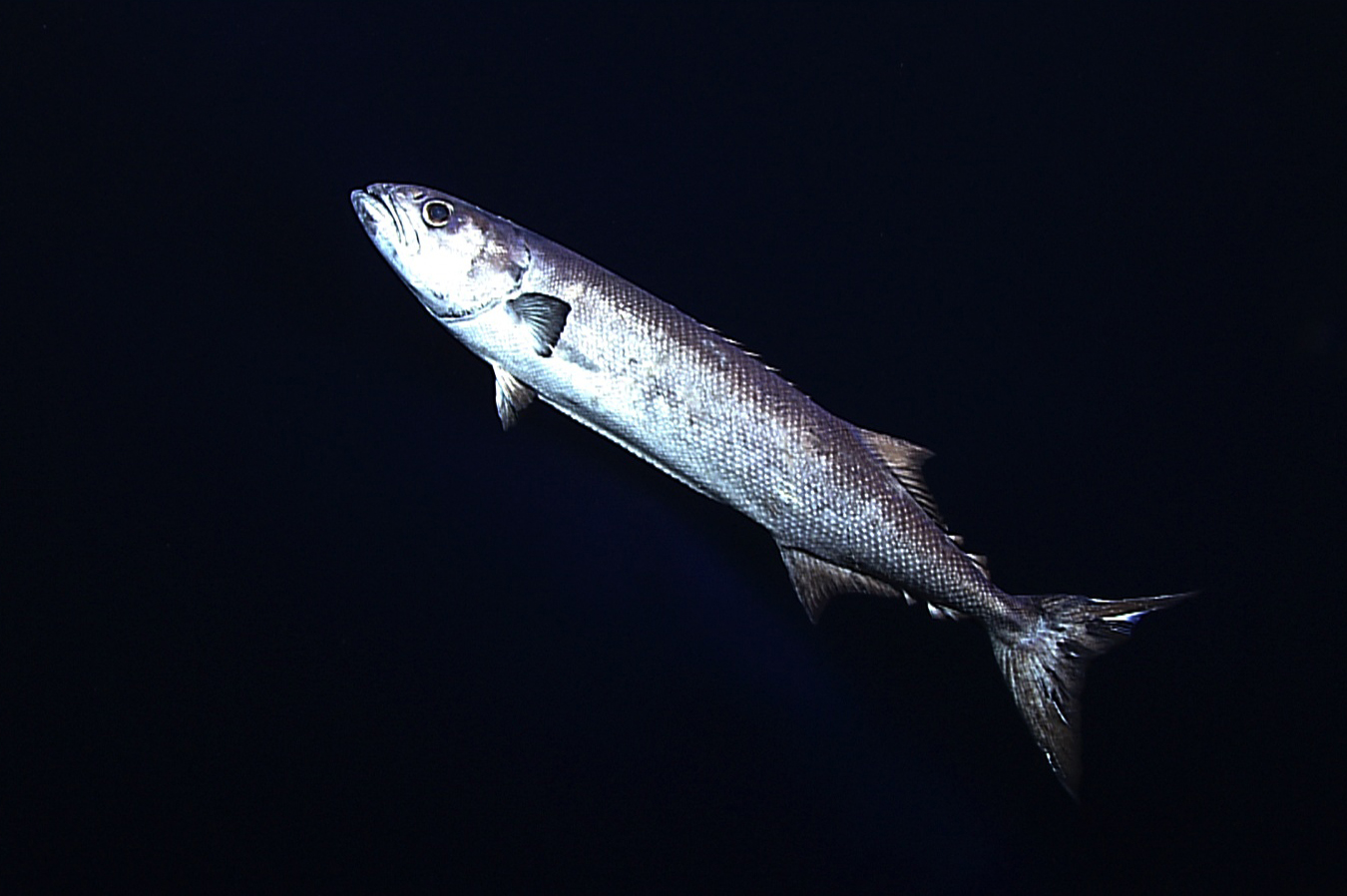Oilfish, Ruvettus pretiosus Cocco 1833

Oilfish, Ruvettus pretiosus. Source: NOAA Okeanos Explorer / NOAA Office of Ocean Exploration and Research. License: Public Domain
A large brown to dark brown snake mackerel, with black tips on the pelvic and pectoral fins black, two finlets behind the dorsal and anal fins, and sharp bony tubercles between the scales. Juveniles have a white margin on the second dorsal and anal fins.
As the common name suggests, the flesh is very oily and has a high wax ester content that is indigestible and acts as a laxative - often causing severe diarrhoea-like symptoms. The flesh of the Escolar (Lepidocybium pretiosus) also contains indigestible wax esters.
Oilfish, Ruvettus pretiosus Cocco 1833
More Info
|
Distribution |
Off Gladstone, Queensland, around southern Australia, to the Northwest Shelf, Western Australia, and the Arafura Sea north of Bathurst Island, Northern Territory. Elsewhere the species is circumglobal in tropical and temperate waters. Oilfish are oceanic and benthopelagic on the continental slope and rises in depths to 1100 m. |
|
Features |
Dorsal fin XIII-XV, 0, 15-18; Anal fin 0, 15-18; Pectoral fin 15. Anal fin followed by two finlets. Pelvic fin with one spine and five soft-rays. Caudal fin forked, lacks keels. Body semi-fusiform and slightly compressed. Body depth 4.3-4.9 times into standard length. Head length 3.3-3.7 times into standard length. Lower jaw slightly protrudes, both jaws lack dermal processes. Loses its fang-like teeth as it matures. Vomer and palatines with small, uniserial, teeth. First gill arch with a noticeably larger t-shaped gillraker at angle of arch. Single lateral line, often obscured by rough skin. Scales small, cycloid and interspersed with spinous bony tubercles. Ventral profile keeled by bony scales. |
|
Size |
To 300 cm, but more commonly to 150 cm. |
|
Colour |
Body brown to dark brown, tips of pelvic and pectoral fins black. Second dorsal fin and anal fin with white margins in juveniles. |
|
Feeding |
Known to feed on fishes, squid and crustaceans. |
|
Fisheries |
Although rarely caught in bottom trawls, the Oilfish is taken as bycatch in the swordfish fishery and in the tuna longline fishery. Consumption may have a purgative effect due to the high wax ester content in the flesh. |
|
Conservation |
None. |
|
Remarks |
This species has been observed swimming solitarily over rocky substrates at depths of up to 900 m. |
|
Similar Species |
The Oilfish differs from the Escolar, Lepidocybium flavobrunneum, in lacking lateral keels on the side of the caudal peduncle, in having fewer finlets behind the second dorsal and anal fins (2 vs. 4-6 in the Escolar) and a larger mouth (extending to below or just beyond the rear of the eye vs. extending to under the front of the eye in the Escolar). Oilfish also have much larger scales than the Escolar. |
|
Species Citation |
Ruvettus pretiosus Cocco 1833, Observationes Peloritani 8: 18. Type locality: Messina, Italy. |
|
Author |
Bray, D.J. & Schultz, S. |
|
Resources |
Oilfish, Ruvettus pretiosus Cocco 1833
References
Cocco, A. 1833. Cenni sui genera Ruvettus e sui caratteri che lo distinguone. Osservationes Peloritani 13: 18.
Collette, B.B., Curtis, M., Smith-Vaniz, W.F., Pina Amargos, F., Williams, J.T. & Grijalba Bendeck, L. 2015. Ruvettus pretiosus. The IUCN Red List of Threatened Species 2015: e.T190432A16644022. http://dx.doi.org/10.2305/IUCN.UK.2015-4.RLTS.T190432A16644022.en. Downloaded on 22 September 2016.
Gomon, M.F. 1994. Family Gempylidae. pp. 813-816, figs 718-720 in Gomon, M.F., Glover, C.J.M. & Kuiter, R.H. (eds) The Fishes of Australia's South Coast. Adelaide : State Printer 992 pp. 810 figs.
Gomon, M.F. 2008. Families Sphyraenidae to Centrolophidae. pp. 774-800 in Gomon, M.F., Bray, D.J. & Kuiter, R.H. (eds) Fishes of Australia's Southern Coast. Sydney : Reed New Holland 928 pp.
May, J.L. & Maxwell, J.G.H. 1986. Field Guide to Trawl Fish from Temperate Waters of Australia. Hobart : CSIRO Division of Marine Research 492 pp.
Nakamura, I. & Parin, N.V. 1993. FAO Species Catalogue. Snake mackerels and cutlassfishes of the world (families Gempylidae and Trichiuridae). An annotated and illustrated catalogue of the Snake Mackerels, Snoeks, Escolars, Gemfishes, Sackfishes, Domine, Oilfish, Cutlassfishes, Scabbardfishes, Hairtails, and Frostfishes known to date. Fisheries Synopsis No. 125, Vol. 15. Rome : FAO 136 pp. 200 figs.
Nakamura, I. & Parin, N.V. 2001. Gempylidae, Trichiuridae. pp. 3698-3720 in Carpenter, K.E. & Niem, T.H. (eds) The Living Marine Resources of the Western Central Pacific. FAO Species Identification Guide for Fisheries Purposes. Rome : FAO Vol. 6 pp. 3381-4218.
Pakhorukov, N.P. 2008. Visual Observations of Fish from Seamounts of the Southern Azores Region (the Atlantic Ocean). Journal of Ichthyology 48(1): 114-123.
Pepperell, J. 2010. Fishes of the Open Ocean a Natural History & Illustrated Guide. Sydney : University of New South Wales Press Ltd 266 pp.
Weber, M. 1913. Die Fische der Siboga-Expedition. Sitzungsberichte der Akademie der Wissenschaften in Wien. Mathematisch-Naturwissenschaftliche Klasse 57: 1-710 123 figs 12 pls (p. 401 as Ruvettus tydemani)
Yearsley, G.K., Last, P.R. & Ward, R.D. (eds) 1999. Australian Seafood Handbook. Hobart : CSIRO Marine Research 460 pp.





